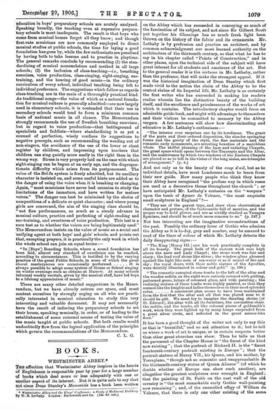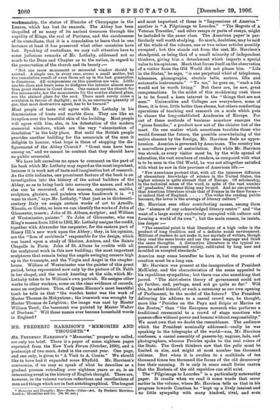BOOKS.
WESTMINSTER ABBEY.* Pp; affection that Westminster Abbey inspires in the hearts of Englishmen is responsible year by year for a large number qf books which deal more or le se adequately with one or another aspect of its interest. But it is quite safe to say that llot: since Dean Stanley's 3fevioria1s has a book been written
• • Ifrostininster Abbey nnd the Anis' eraftmen a Stadia of Meriiaeval Building. 3.?7 W. B. Wfuli4Th L•40e; Peekt•orth An4 Co. LI*. #.41. petJ
on the Abbey which has succeeded in conveying so much of the fascination of its subject, and not since Sir Gilbert Scott put together his Gleanings has so much fresh light been thrown on the history of the fabric and its ornaments. Mr. Lethaby is by profession and practice an architect, and by common acknowledgment our most learned authority on the architecture of the thirteenth century, so that what he has to say in his chapter called "Points of Construction," and in other places, upon the technical side of the subject will have great interest for all students and amateurs of the art. But to the general reader it is the virtuoso in Mr. Lethaby, rather than the professor, that will make the strongest appeal. If it was the historical imagination of Dean Stanley which first made vivid to the nation the claim of the Abbey to be the central shrine of its Imperial life, Mr. Lethaby is as certainly the first writer who has succeeded in making his readers realise wherein lies the distinctive beauty of the building itself, and the excellence and pricelessness of the works of art which it contains. The introductory chapter would form an admirable guide-book, and might with advantage to themselves and their visitors be committed to memory by the Abbey vergers. A few sentences will show how discriminating and educative is Mr. Lethaby's enthusiasm :—
"The interior ever surprises one by its loveliness. The grace of the parts and their ordered disposition, the slender springing forms and the gaiety of tho style, the fine materials and the romantic early monuments, are arresting beauties of a matchless whole. The skilful planning of the Apse and radiating Chapels, the great space which opens 'between the Transepts and the Altar, and the contrivance by which two windows of the Eastern Chapels are placed so as to tell in the vistas of the long aisles, are triumphs of arrangement." (p. 4.) And not only as to the beauty of the coup d'ceil, but as to individual details, have most Londoners much to learn from their new guide. How many people who think they know their Abbey have recognised "the profuse way in which roses
are used as a decorative theme throughout the church " ; or have anticipated Mr. Lethaby's ecstasies on the " weepers " upon the tomb of Aymer de Valence, "the most exquisite small sculptures in England"
They are of the gayest type and show close observation of character and gesture, of the fashionable fall of mantles, and the proper way to hold gloves, and are as vividly studied as Tanagr* figurines, and should be of much more concern to us." (p. 247.)
Not less interesting are the imaginative reconstructions of the past. Possibly the ordinary lover of Gothic who admires
the Abbey as it is to-clay, grey and sombre, may be amazed to read of the blaze of colour of which Mr. Lethaby detects the daily disappearing signs :—
"The King [Henry III.] saw his work practically complete in all its beauty. The great bulk of the eastern work rose high above the nave and Lady Chapel ; the stone work was fair and sharp ; the lead roof shone like silver ; the window-glass gleamed against the light like nets of sea-water or as if mixed of fire and sky ; the royal doors, with their noble statues of the Apostles, were daintily illuminated in colour and gold." (p. 198.) "The romantic canopied stone tombs to the left of the altar and the wooden sedilia on the right were entirely covered with gilding, patterned gesso, inlays of coloured glass, and with painting the reclining statues of these tombs were highly painted, so that they seemed like the knights and ladies themselves in their most splendid robes A consistent plan seems to have been maintained from the first that the altar and all that was plaeed near to it should be gilt. We must try to imagine the dazzling shrine [of St. Edward], the altar with all its furniture, the coronation chair, the sedilia, and the tombs, all like colossal pieces of goldsmith's work, when they were lighted up by many lamps suspended from a great silver circle, and reflected in the great mirror-like floor.'
It has been a good thought of the writer not only to say this or that is " beautiful," and so ask attention to it; but to tell us where a work of art is unique, or in certain respects better than other great churches can show. Thus he tells us that the pavement of the Chapter House is "the finest of the kind now existing"; that the portrait of Richard IL is the "finest fourteenth-century portrait existing in Europe " ; that the portrait statues of Henry VII., his Queen, and his mother, by Torregiano, "though not so romantic and unapproachable tte the thirteenth-century statue of Queen Alianor " (of which he doubts whether all Europe can show such another), are altogether the greatest sculptures ever wrought in England ;
that the painting of St. Faith on the east wall of the old rpvestry is " the most remarkable early Gothie wall-painting now remaining " ; and, of the enamelled effigy of William de Valence, that there is only one other existing of the same
workmanship, the statue of Blanche of Champagne in the Louvre, which has lost its enamels. The Abbey has been despoiled of so many of its ancient treasures through the cupidity of Kings, the zeal of Puritans, and the carelessness of its custodians, that it is a consolation to learn that in one instance at least it has preserved what other countries have lost. Speaking of custodians, we may call attention here to some judicious remarks of Mr. Lethaby, addressed not so much to the Dean and Chapter as to the nation, in regard to the preservation of the church and its beauty :—
"Not one more monument or memorial window should be erected. A single one, in every case, seems a small matter, but the cumulative result of even those set up in the last generation is disastrous. All compromises on this question are vain. Little marble discs and busts seem to disfigure the interior almost more than great statues in Court dress. One cannot see the church for the monuments, nor the monuments for the sombre stained glass, nor the stained glass for the soot. There must surely come a revulsion in favour of daylight ; as it is, an enormous quantity of gas, that most destructive agent, has to be burned."
Most people of taste will agree with Mr. Lethaby in his denunciation of busts and marble discs. They are like an irruption over the beautiful skin of the building. Most people will agree with him, also, in his detestation of the modern memorial windows, whieh are the very "abomination of desolation" in the holy place. But until the British people provides, another building for the memorials of the men it delights to honour, what hope is there of stopping the dis- figurement of the Abbey Church ? "Great men have been among us," and we cannot be content that they should have no public memorial.
We have left ourselves no space to comment on the part of his book which Mr. Lethaby may regard as the most important, because it is work not of taste and imagination but of research. As the title indicates, one prominent feature of the book is an investigation into the history of the actual builders of the Abbey, so as to bring back into memory the names, and what else can be recovered, of the masons, carpenters, smiths, sculptors, glaziers, and painters whose handiwork it is. "I want to show," says Mr. Lethaby,-" that just as in thirteenth. centuryItaly we assign certain works of art to Arnolfo, Niccolo, or Giotto, so here we can identify the works of John of Gloucester, mason ; John of St. Albans, sculptor ; and William of Westminster, painter." To John of Gloucester, who was King's mason from 1254 to 1262, Mr. Lethaby assigns the credit, together with Alexander the carpenter, for the eastern part of Henry new work upon the Abbey ; they, in his opinion, are the "firm of architects" responsible for the design, which was based upon a study of Rheims, Amiens, and the Sainte Chapelle in Paris. John of St. Albans he credits with all the sculptural work in this new building; the most important sculptures that remain being the angels swinging censers high up in the transepts, and the Virgin and Angel in the chapter- house. William of Westminster was the painter of this great period, being represented now only by the picture of St. Faith in her chapel, and the monk kneeling at the side, which Mr. Lethaby takes to be William's own portrait. He assigns other works to other workers, some on the clear evidence of records, some on conjecture. Thus, of Queen Eleanor's most beautiful tomb he tells us that "the wooden tester was the work of Master Thomas de Hokyntone ; the ironwork was wrought by Master Thomas de Leighton ; the image was cast by Master William Torel ; the basement was painted by MaSter Walter of Durham." Will these names ever become household words in England ?



































 Previous page
Previous page